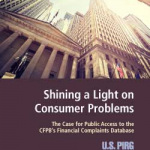
Shining A Light on Consumer Problems:
The Case for Public Access to the CFPB’s Financial Complaints Database
Our report, Shining A Light on Consumer Problems: The Case for Public Access to the CFPB’s Financial Complaints Database, details why it is important that the highly successful Consumer Financial Protection Bureau database of over one million consumer complaints remain open to the public, so consumers, researchers and others can study the financial marketplace.
Downloads
U.S. PIRG Education Fund

Executive Summary
The public Consumer Complaint Database operated by the Consumer Financial Protection Bureau is a critical tool for understanding consumer problems in the financial marketplace. The database contains more than one million complaints and has proven useful for consumers, academic researchers, watchdog organizations, and businesses, while bringing transparency and accountability to companies that provide financial services and products.
Yet today, the future of public access to the Consumer Complaint Database is uncertain, as CFPB acting director Mick Mulvaney has indicated that he may block public access to complaint data.[1] And in March 2018, the CFPB issued a formal request for information that could signal the beginning of a process to remove public access.[2] To protect consumers, the CFPB should maintain public access to its Consumer Complaint Database, and resist attempts to limit its scope or the information it contains.
The public complaints database provides consumers with a rich trove of information to navigate the financial marketplace.
- As of May 2018, the complaints database contained more than one million complaints and 280,000 consumer complaint narratives; it included complaints from all 50 states and from 28,000 zip codes.
- Consumers can review complaints related to dozens of different financial products – from checking accounts to credit reports – and nearly 5,000 companies.
- Consumers can see how companies responded to the complaints, using information in the database to determine whether companies responded to the complaints promptly and offered either monetary or non-monetary relief to consumers in response to complaints.
Public complaints allow watchdog groups, academics, and the private sector to highlight problems and help consumers.
- Analyses of public complaint data have employed a wide variety of perspectives and research tools. For example, the Center for Responsible Lending applied a detailed categorization to complaint narratives and found that confusion over account balances was a primary factor in problems involving overdraft fees.[3] And for a study published in Duke Law School’s publication Law and Contemporary Problems, researchers performed a psychological analysis of complaint language and recommended ways that the CFPB could employ text analysis tools to better meet consumer needs.[4]
- Public complaint data has helped reveal problems in the financial services industry. Analyses of complaints exposed problems with TCF National Bank, Wells Fargo and Sallie Mae before each company was penalized for consumer mistreatment.[5]
- Watchdog groups can also use complaints to highlight good practices by financial companies. A U.S. PIRG Education Fund report on overdraft fees found that Citibank had the lowest number of complaints (normalized by customer accounts) about issues caused by low account funds.[6] Further research revealed that Citibank followed several best practices for limiting overdraft customer fees.[7]
Public complaints hold financial services firms accountable and help them serve their customers.
- Websites providing consumer reviews of goods and services have revolutionized consumers’ experience of the marketplace, and surveys have found that the vast majority of consumers are influenced by online reviews.[8] Because consumers rely heavily on online information, putting consumer complaints online is a powerful tool for keeping financial companies accountable.
- Public complaints include certain information about customer experiences that can be particularly revealing – and companies use this information to improve their practices. For example, the database includes information on whether companies promptly respond to consumer complaints.
- Public complaints can also be useful for companies seeking to improve their business and customer relationships. According to consulting firm Deloitte, companies can analyze complaints and “use the resulting insights to potentially improve their regulatory compliance efforts, customer experience, and their own operational effectiveness.”[9]
Public complaints keep the CFPB accountable.
- The public database is a powerful tool for consumers and the public to conduct their own assessment of consumer treatment in the financial marketplace – and to ensure that the CFPB is faithfully and effectively following through on its mission of protecting consumers.
- Public complaints can indicate problems in the financial marketplace deserving of the CFPB’s attention. The CFPB has used the complaint database to justify its own decisions to prioritize work on credit reporting accuracy and debt collection, and the public can similarly use complaint data to assess the CFPB’s work.[10]
- The transparency afforded by public complaints is important for industry – the database has even been used by industry groups to argue for weaker enforcement. According to American Banker, the payday lending industry frequently cites public complaint data in their arguments for less oversight.[11] (Ample research indicates that payday loans, in fact, cause enormous pain for consumers.)[12]
By law, two of the primary missions of the CFPB are providing consumers with “timely and understandable information to make responsible decisions about financial transactions,” and ensuring that “markets for consumer financial products and services operate transparently and efficiently to facilitate access and innovation.” The CFPB’s public Consumer Complaint Database helps accomplish both missions. To continue to serve the public, and to ensure that consumers have the protection they deserve in the financial marketplace, the CFPB should maintain an open and accessible Consumer Complaint Database.
[1]Stacy Cowley, “Consumer Bureau Looks to End Public View of Complaints Database,”The New York Times, 25 April 2018.
[2]Consumer Financial Protection Bureau, Request for Information Regarding Bureau Public Reporting Practices of Consumer Complaint Information – Docket No. CFPB-2018-0006, 6 March 2018, available at https://www.regulations.gov/docket?D=CFPB-2018-0006.
[3]Rebecca Borné, Peter Smith, and Rachel Anderson, Center for Responsible Lending,Broken Banking: How Overdraft Fees Harm Consumers and Discourage Responsible Bank Products, May 2016.
[4]Pamela Foohey, “Calling on the CFPB for Help: Telling Stories and Consumer Protection,”Law and Contemporary Problems, 80: 177-209, 2017, available at http://scholarship.law.duke.edu/lcp/vol80/iss3/8.
[5]Wells Fargo: Tony Dutzik et al., Frontier Group and U.S. PIRG Education Fund, Big Banks, Big Complaints, September 2013; TCF National Bank: Gideon Weissman, Frontier Group Edmund Mierzwinski, U.S. PIRG Education Fund, Big Banks, Big Overdraft Fees, December 2016; Sallie Mae: Brandon Purcell, Beyond the Arc,A Warning to Sallie Mae from the CFPB Database(blog post), 19 August 2013, archived at http://web.archive.org/web/20160307122503/http://beyondthearc.com/blog/2….
[6]Gideon Weissman, Frontier Group Edmund Mierzwinski, U.S. PIRG Education Fund, Big Banks, Big Overdraft Fees, December 2016.
[7]Gideon Weissman, Frontier Group Edmund Mierzwinski, U.S. PIRG Education Fund, Big Banks, Big Overdraft Fees, December 2016.
[8]BrightLocal, Local Consumer Review Survey, 2017, archived at http://web.archive.org/web/20180303130120/https://www.brightlocal.com/learn/local-consumer-review-survey/; Dimensional Research, Customer Service And Business Results: A Survey Of Customer Service From Mid-Size Companies, April 2013, archived at http://web.archive.org/web/20180510105118/https://www.zendesk.com/resour….
[9]Deloitte, CFPB’s Consumer Complaint Database Analysis Reveals Valuable Insights, September 2013, archived at http://web.archive.org/web/20160910025733/http://www2.deloitte.com:80/co….
[10]Consumer Financial Protection Bureau, Policy Priorities Over the Next Two Years, February 2016, archived at http://web.archive.org/web/20171129125419/http://files.consumerfinance.g….
[11]Kevin Wack, “The Downside of Scaling Back the CFPB Complaint Database,” American Banker, 26 June 2017, archived at http://web.archive.org/web/20170912121550/https://www.americanbanker.com….
[12]Pew Charitable Trusts, Payday Loan Facts and the CFPB’s Impact, 14 January 2016, archived at http://web.archive.org/web/20171020005250/http://www.pewtrusts.org:80/en….
Topics
Find Out More


Safe At Home in 2024?

What the California Consumer Privacy Act means for you
